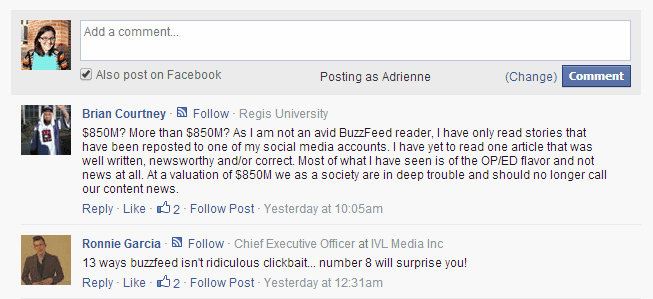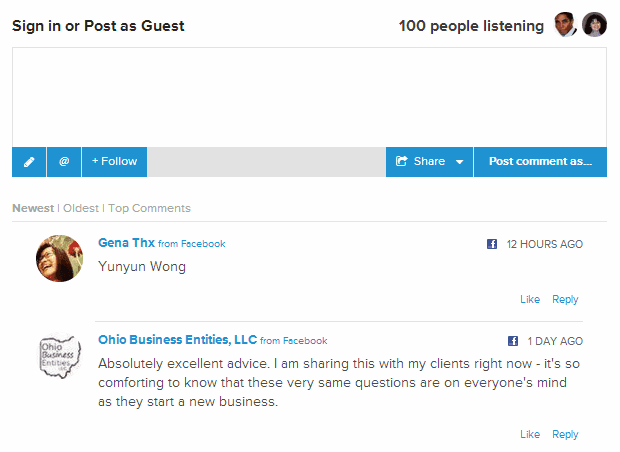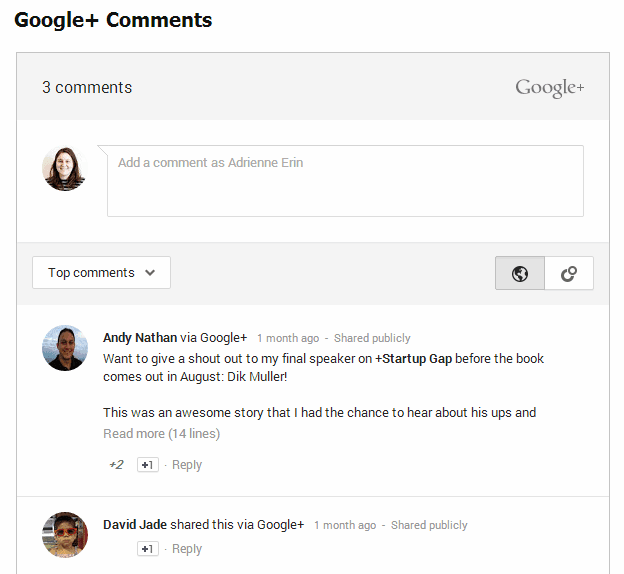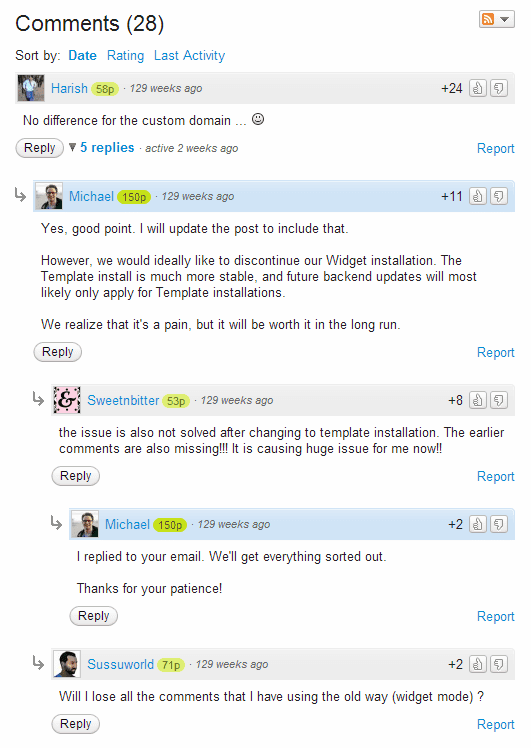8 Comment Systems You Can Use On Your WordPress Blog
 Blog comment systems accomplish two things for bloggers: they provide valuable social proof, and they can be a great place to foster reader engagement and get more mileage from your article. With some of the comment systems available today, readers can integrate social media platforms, and even use @mentions to engage more participants in the conversation. For you, the blog owner, this means more people will likely read your work.
At the same time, comment monitoring can be a lot of work.
There's always the possibility spammers will get through, even if you have a good filter. Comment trolls–or even real users–will purposely post offensive or controversial comments just to get a reaction. You may prefer to use a simple interface for your blog's comments, but are concerned about these spammers and trolls.
Which comment system should you use on your WordPress blog to deal with this? Let's look at eight of the most popular comment options out there, and see which is best for you.
Blog comment systems accomplish two things for bloggers: they provide valuable social proof, and they can be a great place to foster reader engagement and get more mileage from your article. With some of the comment systems available today, readers can integrate social media platforms, and even use @mentions to engage more participants in the conversation. For you, the blog owner, this means more people will likely read your work.
At the same time, comment monitoring can be a lot of work.
There's always the possibility spammers will get through, even if you have a good filter. Comment trolls–or even real users–will purposely post offensive or controversial comments just to get a reaction. You may prefer to use a simple interface for your blog's comments, but are concerned about these spammers and trolls.
Which comment system should you use on your WordPress blog to deal with this? Let's look at eight of the most popular comment options out there, and see which is best for you.
#1 - Default WordPress Comment System
Despite the increasing number of comments systems out there, many blogs still decide to use the default comments from WordPress. This system is free, prepackaged in your WordPress install, easy to use, and can be customized endlessly through plugins.WordPress Comments: Pros
WordPress’s own comments section has a number of perks which makes it popular with WordPress bloggers.- Control filter preferences. Through automated moderation and spam filter settings, WordPress blog administrators can set their own preferences for how the site will filter content. You can filter out certain users, keywords or IP addresses.
- Control anonymity preferences. You can also decide whether or not users need to provide an email address, name or registration confirmation before commenting.
- Control moderation preferences. You can decide if and how you will moderate comments, choosing settings that allow you approve first-time comments, all comments, or no comments.
- Low barrier to entry. WordPress comments don't require registering for yet another account in order to leave a simple comment. It's easy to leave a comment, and readers like that. They don't have to jump through hoops to participate.
WordPress Comments: Cons
WordPress’s comment interface has not really been updated much in over a decade, and sometimes this shows. A lot has happened in that decade. For example, social media happened in that decade. WordPress’s comments aren’t the best for social media integration, especially if you would rather not use any extra plugins. Furthermore, the spam controls aren’t all that great, and spam comments often make it past Akismet, WordPress’ free comment spam filtration plugin. Granted, you can upgrade your spam filtering using other plugins like Mollom, which asks users to solve a captcha only if it is unsure about the content of the message. Mollom has its own privacy policy, though, and for readers that don't like third-party comment systems, they may balk at Mollom even though you are using the WordPress comment system.#2 - Facebook Comment System
 Using Facebook comments brings the discussion from the network to your blog.
Facebook comments have the two things WordPress lacks — social media integration and better troll control. For this reason many popular sites, such as TechCrunch, have adopted Facebook comments for their blogs.
Using Facebook comments brings the discussion from the network to your blog.
Facebook comments have the two things WordPress lacks — social media integration and better troll control. For this reason many popular sites, such as TechCrunch, have adopted Facebook comments for their blogs.
Facebook Comments: Pros
Why are Facebook comments growing in popularity?- Proof of a real person. If you have a Facebook account, you are probably a real person which (in theory) greatly reduces the likelihood that you’ll post spam. Requiring users to login with Facebook also verifies their identity, and, in general, blog owners have found users are less likely to post offensive or trolling content if it’s under their real name.
- Low barrier to entry. Most of us have a Facebook account. Many users will be more likely to log in with social media than create a new account on the site, which can increase the number of comments you receive.
- Increased shares of post. Facebook comments make your blog content more likely to be shared on that popular network. This kind of share, with a person's commentary, is more powerful than a mere like.
Facebook Comments: Cons
Although Facebook may seem ubiquitous, not everyone uses it. By adopting a Facebook comment system, you could alienate users who choose not to use Facebook. Some people also may not want to have their comments traced back to their real identity or Facebook account, even if they are not posting anything offensive. In addition, Facebook comments are not linked to your blog. If you ever change your commenting system, you’ll lose your old comments.#3 - Disqus Comment System
 Disqus comments offer several social features in their commenting system.
Disqus gives you everything you could ever want in a comments system. You can seamlessly integrate social media, add interactive content such as pictures and videos and cut down on spam. There are many blogs out there (including the CoSchedule blog) that have adopted the Disqus comment system.
Disqus comments offer several social features in their commenting system.
Disqus gives you everything you could ever want in a comments system. You can seamlessly integrate social media, add interactive content such as pictures and videos and cut down on spam. There are many blogs out there (including the CoSchedule blog) that have adopted the Disqus comment system.
Disqus: Pros
Disqus is an increasingly common comment system for many sites, and it's easy to see why.- Social media integration. Disqus has excellent social media integration. You can share comments and reactions on Facebook, Twitter and similar sites. You can even tag Disqus and Twitter users with @mentions to direct the conversion at others who may be interested.
- Real time commenting. Disqus also tracks comments in real-time so users see the most recent comments first. In addition, Disqus provides user analytics, has a discovery feature to help increase traffic and has great spam control features.
- Great admin controls. As the owner, you can easily moderate and control what comments get published from your Disqus dashboard or by replying to emails. This makes it simple to maintain your comment section as you check your email.
Disqus: Cons
Disqus is not everyone's favorite system, particularly for readers. They don't like the idea of having to register for another account just to leave a comment. https://twitter.com/Jenn_Mattern/status/428137896118587392 Disqus is not as easy to use as WordPress or Facebook comments and, to get the full version, you’ll also have to pay a fee. It may be more time and money than some people are willing to invest in a comments system. Some readers don't want to see the most recent comments first because it can create confusion; they'd rather see them in ascending order (first and oldest on top, newer on bottom) so they can follow the progression of the conversation easier. Additionally, readers can't build backlinks through Disqus unless they post a link directly in the comment. That might be considered a positive for you, the blog owner, though, if you wish to avoid commenters only participating for backlinks.#4 - LiveFyre Comment System
 LiveFyre is similar to Disqus in its implementation.
LiveFyre is similar to Disqus in that it is a third-party comment system with a host of quite similar great features. Entrepreneur is one example of a site that uses LiveFyre to manage its comments.
LiveFyre is similar to Disqus in its implementation.
LiveFyre is similar to Disqus in that it is a third-party comment system with a host of quite similar great features. Entrepreneur is one example of a site that uses LiveFyre to manage its comments.
LiveFyre: Pros
Both users and admins have reason to love LiveFyre as a commenting system. Though similar to Disqus, there are several unique features that set it apart.- Flexible login options. You can either log in with Facebook or Twitter or create your own LiveFyre account.
- Social media integration. Once you’re logged in, LiveFyre’s SocialSync setting can automatically link conversations to your social media accounts. Similar to Disqus, you can tag other users with @mentions and integrate media in their comments. But here's what's interesting: You can even share the comments themselves on social media networks.
- Great admin controls. Administrators can track user activity and see who is actively participating in the conversation.
LiveFyre: Cons
Like Disqus, LiveFyre also charges a fee for anything but the most basic version. While the features are certainly cool and give you a lot of options, they may also be more complicated than what most bloggers are looking for. Additionally, LiveFyre shares readers' last post in the comment sections. While that is a benefit for readers and helps bring traffic back to their blog, you may prefer to keep your comment section free from that kind of unrelated self-promotion.#5 - Google+ Comments
 Google+ is a great network to be active on because the content shows up in Google search results; you can increase your website's presence on Google+ by setting your comments up to encourage it. Some Google+ users have turned to the network for actual blogging, but using the network for a comment system is probably the better integration.
Google+ is a great network to be active on because the content shows up in Google search results; you can increase your website's presence on Google+ by setting your comments up to encourage it. Some Google+ users have turned to the network for actual blogging, but using the network for a comment system is probably the better integration.
Google+ Comments: Pros
Since there is no official Google+ Comments plugin for WordPress, you'll need to bring them in using a third-party plugin like Comments Evolved.- Less anonymity. Although it's not terribly hard to set up a throwaway Google account in order to submit some anonymous comments, many potential trolls won't bother. YouTube's switch from usernames to Google+ accounts was undoubtedly good for their comments section, and making the switch on your own blog could have similar good results.
- Low barrier to entry. Most of us have a Google account. Like with Facebook comments, users are more likely to comment if they already have an account than if they have to create an entirely new one just to leave a comment.
- Increased Google+ shares. Google+ shares are great social signals for your Google presence. And, just as with Facebook comments, this system makes it more likely that your content gets shared on the Google+ network, not just +1'd.
Google+ Comments: Cons
Google+ Comments can be alienating in the same sort of way that Facebook Comments can be. Most people use Google products, but not everyone does, nor is everyone open to tying their online identity to your comments section. This is probably somewhat less of a concern than with Facebook Comments, however, since many people have more than one Google account. And, until Google+ has an official WordPress plugin, you will have to rely on third-party plugins and how they handle comments. For example, Comments Evolved essentially gives you tabs for different types of comments, but to my knowledge there is no combined feed of all of your comments. This can get confusing fast if you have multiple conversations happening on multiple comments tabs on just one post. This is just the case for Comments Evolved, however; you have many other options when it comes to Google+ comment plugins. Pay attention when picking out your third-party plugin to add Google+ Comments. Since there is no official Google plugin, it's a wide open market, and some developers may have ulterior motives. The reviewers on one plugin to add Google+ Comments that I came across noted that the plugin added a "hidden backlink" to their blog. Not cool.#6 - IntenseDebate Comment System
 IntenseDebate offers subscription settings through RSS and email, social media integration, a user-ranking feature and CSS integration. It doesn’t have quite as many features as LiveFyre or Disqus, but if you’re a pro at CSS this could be the system for you.
IntenseDebate offers subscription settings through RSS and email, social media integration, a user-ranking feature and CSS integration. It doesn’t have quite as many features as LiveFyre or Disqus, but if you’re a pro at CSS this could be the system for you.
IntenseDebate: Pros
IntenseDebate was clearly created with the community in mind. Some of its best features include:- Threaded comments. Other comment systems struggle to balance a hierarchy of responses with a chronological order. The threaded comments and clear places to jump into the conversation makes this system great for debates and lively commentary.
- A rating system. It can be discouraging to leave a thoughtful comment if you're never going to get anything back out of it. The thumbs-up and thumbs-down feature rewards great responses and also makes it easy to float the best replies to the top (just click "Rating"). This way, your best commenters are rewarded and encouraged to continue participating.
- Community self-moderation. The "report" feature lets your community help you moderate comments. They can vote down and flag bad comments, encouraging higher quality responses overall. This is helpful if you can't always be there to monitor your comments.
IntenseDebate: Cons
For me, one of the biggest cons of IntenseDebate is that you need to scroll all the way to the bottom of a sometimes extended set of comments (hey, it's called IntenseDebate for a reason) in order to add a comment as a new thread. Some may not consider this a con though; it encourages your readers to read the other comments before replying themselves, and could result in more banter between your readers (there are reply buttons all through the threads). Still, for those readers who want to comment on your blog post and not involve themselves in the rest of the debate, this will be an annoyance. Also, the reliance on CSS might make this system a little unwieldy for some users. However, they have a small but dedicated community of users you can turn to for help. People tend to like this comment system.#7 - Vicomi Comment System
 Vicomi is a simple system with a single selling point — the emoticon.
With Vicomi, you no longer have to worry if someone is trying to be sarcastic or if they're sincerely upset. Users can post the emoticon along with their comment to share their emotion, clearing up any doubts you might have.
Vicomi is a simple system with a single selling point — the emoticon.
With Vicomi, you no longer have to worry if someone is trying to be sarcastic or if they're sincerely upset. Users can post the emoticon along with their comment to share their emotion, clearing up any doubts you might have.
Vicomi: Pros
- Uniqueness. Vicomi comments are certainly eye-catching.You might start getting more comments simply because you've got such a different comments system from everyone else.
- Gamification. Commenters are rewarded with "credits" for participating meaningfully in discussions, and you can set up these credits to be redeemable in different ways. Comments can be recommended or flagged by your audience, a sort of self-moderation.
- Easy dashboard. Vicomi provides its own comment moderation dashboard, making it easier to get through your comments than some other systems.
Vicomi: Cons
The biggest thing Vicomi has going against it is how unheard of it is. It's pretty much a guarantee that if you install Vicomi, it will be new to your audience, and that could be a good thing or a bad thing. It also looks a little childish; the emoticons would look very out of place on a serious or professional blog. However, these cons are subjective to specific types of blogs and readers. If these cons don't apply to you and your blog, Vicomi comments could be worth a try; they're free and relatively simple to install.#8 - No Comments Section
Many bloggers argue that comments are an integral part of blogging, but despite the wide range of comments systems available, some websites decide to bypass comments altogether. Why would you do that?No Comments: Pros
There are a few valid reasons for turning your comments off (or shutting them down on individual posts after specified amounts of time):- No more negative social proof. Even if your blog is getting a decent amount of traffic or social activity, seeing that "0" beside every post can be a bit of a buzzkill. It can make your audience think that you don't have readers or you don't have content worth commenting on.
- No more quandaries over which comments to publish and which to trash. Look at any highly-trafficked site with a comments section and you've noticed that comment sections can get ugly. Even if you have a blog EULA, trying to decide whether or not to post someone's passionate, well-argued reply that happens to contain insults about other commenters can be a huge headache.
- No more tyranny of the minority. Popular Science turned off its comments in 2013, saying that a particularly vociferous small group of commenters can skew a reader’s perception of a story so that it no longer carries the intended meaning.
- It puts the conversation on social media. Upworthy chose not to include a comments section on their site, so that the conversation can take place on Facebook, where it can spread virally to bigger and bigger audiences.
No Comments: Cons
While there are pretty clear-cut benefits of ditching your comments section, the disadvantages are obvious as well. Without a comments section you have far less of a chance of developing an active community around your content. Even if you do, the fact that it is removed (taking place on Facebook, Twitter, or elsewhere) will alienate some readers. If the discussion is taking place elsewhere, often people will link to where the action is - even if that means embedding a couple tweets about your piece instead of linking to it directly.---
Whatever comment system you choose, there are bound to be pros and cons, and that's okay. Not every type of comment system works for every blog or community; that's why we have so many different options.


